A traditionally British Christmas

Twinkling lights, warming treats and some ever-so festive entertainment, the holiday season is when Britain’s cosiness levels reach an all-time high. Discover the background stories and history behind some of Britain’s best-loved and downright delicious festive traditions – from mince pies to the Queen’s speech – for a very British Christmas!
Christmas lights
Illuminating the crisp winter streets with lights each winter, these festive displays fill the air with Christmas cheer and can be switched on from as early as mid-November. Now a well-known tradition, twinkling fairy lights can be seen in countless parts of Britain, from the palatial corners of Regent Street in the capital to quaint towns such as Harrogate in Yorkshire. Electric bulbs were first used to add a touch of magic to the winter festivities in 1881, a year that saw the Savoy Theatre in London’s West End become the first building in the world to be entirely lit by electricity!
Traditional pantomimes
From fairy lights on the streets to the limelight of the stage, pantomimes are a Christmas tradition enjoyed by family members both young and old. Even performed by Queen Elizabeth and Princess Margaret during their childhoods in Windsor Castle, the shows are often extravagant retellings of classic tales such as Dick Whittington, Cinderella or Snow White and the Seven Dwarves. Pantomimes (or ‘pantos’, as they are often called in Britain) are comedic, heart-warming shows which regularly call for audience participation, having them join in with the teasing of certain characters – with raucous ‘booing’ and ‘hissing’ sounds reverberating around local theatres.
The history of pantomimes dates back to the Middle Ages, where religious tales highlighting the triumph of good over evil were performed. The theatrical style of the performances has its foundations in 14th-century court entertainment, which commonly featured song and dramatic mime.
The Trafalgar Square tree
One of London’s best-known festive traditions is the annual Christmas tree displayed in the heart of Trafalgar Square. First gifted to Britain from Norway in 1947, in thanks for the country’s support during the Second World War, the tree has become an annual tradition and sits proudly at the centre of the square bedecked in dazzling strings of fairy lights. Meanwhile, many families also choose to celebrate the holidays with their own ornately decorated Christmas tree, a custom first introduced to the people of Britain by Queen Charlotte, wife of King George III, in 1800!
Festive foods
For many, winter festivities mean tucking into some deliciously warming food and drink. This is certainly the case in Britain, as the holiday season welcomes traditional treats such as mince pies and Christmas pudding. Mince pies have been enjoyed by Brits since the Tudor period, when they were known as ‘shrid’ pies and stuffed with a savoury meat filling! Now mixing fruit and spices encased in a buttery pastry, they are a firm favourite in festive Britain.
Also soaked in warming spiced fruit, but with an alcoholic twist, is the classic Christmas pudding. Made from dried fruit, spices and brandy, the traditional Christmas pudding is an iconic part of Christmas day lunch across Britain. Dating back to medieval times, this potent pudding was created with a high alcohol content to prevent it from spoiling too quickly. To give it an added touch of festive flare, it is usually set on fire as it’s served, an effect created by pouring a pre-lit ladle of brandy over the pud before it is presented at the table!
But before the sweet treats arrive, many people tuck into what is one of the heartiest meals of the year – the Christmas Day roast with all the trimmings! Traditional lunch plates will feature carrots, Brussel sprouts, Yorkshire puddings, gravy, turkey and beloved roast potatoes, but there are many popular additions to the menu, from honey-roasted parsnips to chestnut, bacon and cranberry stuffing!
Christmas crackers
No Christmas dinner in Britain would be complete without the ceremonial pulling of the crackers, traditionally used to decorate the table for the day’s feast. These curious paper tubes come primed with a ‘cracking’ mechanism that, when pulled by two people, creates a small bang. Each loaded with a small prize (ranging from bottle openers to magic tricks), classic paper crown hats and an inevitably terrible joke, crackers are a fun addition to the day’s festivities. A relatively modern tradition, these cracking decorations were first introduced in the Victorian period and continue to win the hearts of Christmas-loving Brits to this day.
The Queen’s Speech
After the fun of roast lunches and crackers, fans of the Royal Family sit down to watch the Royal Christmas Message – a staple part of British yuletide since it was first broadcast by King George V on BBC radio in 1932. This royal communication is broadcast to the Commonwealth at three in the afternoon on Christmas Day, highlighting the year’s stand-out events and the monarch’s personal reflections on the past 12 months.
Carols and concerts
Alongside the twinkling streets and decorated dinner tables is the festive joy felt at concerts across Britain. Often adorned with stunning winter-themed wreaths and glistening with tall candles, many churches, concert halls and music venues are filled with the sound of serene Christmas carols over the holiday period. From the palatial York Minster to the Royal Albert Hall, venues across Britain open their doors for special carol singing events each year.
Boxing Day bargains
Falling the day after Christmas, the 26th of December became known as ‘Boxing Day’ in Britain in the Victorian era, when masters of households would give their servants a day off, alongside gifting a box of presents to take home to their families. Now synonymous with ‘big savings’, Boxing Day is traditionally the start of post-Christmas sales across stores in Britain.

